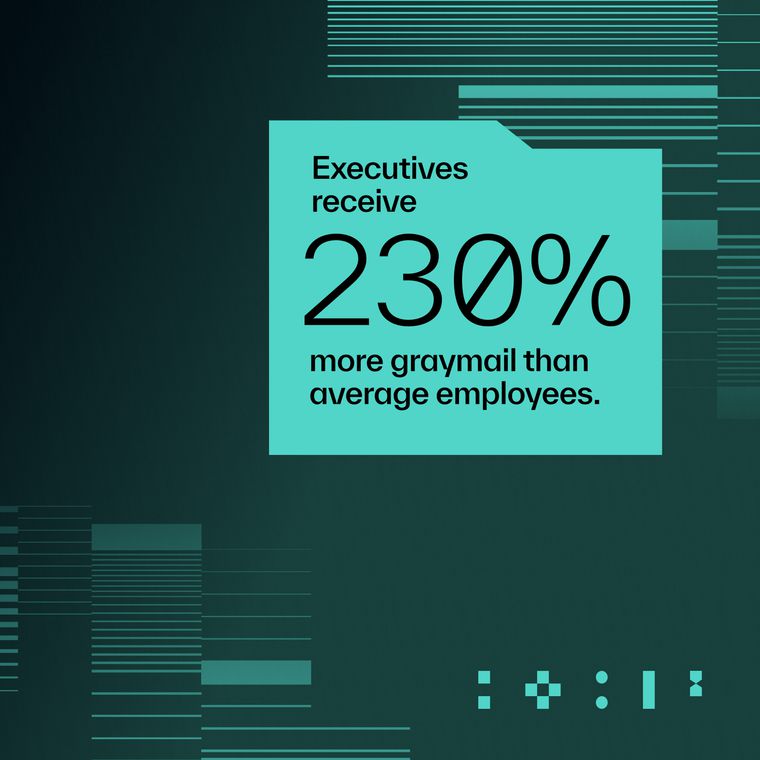Email Security in 2025: 5 Strategies to Stop BEC and Stay Ahead of Modern Threats
Combat business email compromise in 2025 with advanced email security tactics. Discover how AI and machine learning protect your organization.
April 30, 2025
Email is still the most exploited attack vector—and today’s tactics are more convincing than ever.
Email attacks now go far beyond spam and obvious phishing. Cybercriminals use advanced technologies to craft personalized attacks that bypass traditional filters. AI-generated phishing uses perfect grammar, relevant context, and personal details, making malicious messages nearly indistinguishable from legitimate ones.
In fact, 98.4% of security leaders believe attackers are already using AI against them, underscoring just how quickly these tactics are being adopted.
Legacy defenses built on static rules and known indicators aren’t enough. To stop today’s attacks, you need adaptive email security that uses behavioral analysis, machine learning, and real-time threat intelligence to detect threats before they reach the inbox.
This isn’t just about breach prevention. As email threats grow more sophisticated, so do the risks to business continuity, compliance, and stakeholder trust. The time to rethink your email security strategy is now.
1. Understand the Evolving Email Threat Landscape
Sophisticated email threats are now the norm. From AI-generated phishing to impersonation attacks, modern attack campaigns are built to evade legacy defenses and exploit human trust.
In fact, most email attacks now involve social engineering, relying on psychological manipulation—not malware—to trick recipients into taking harmful actions. Defending against these attacks starts with knowing what today’s threats look like.
Business Email Compromise (BEC)
BEC exploits trust by impersonating executives, vendors, or partners to trick employees into transferring funds or sharing sensitive information. These attacks bypass traditional filters because they often lack attachments or malicious links.
As BEC attacks continue to increase and attackers constantly evolve their tactics, legacy solutions struggle to keep up and keep organizations safe.
One way to prevent BEC attempts is through behavioral analysis. By learning normal communication patterns—such as writing style, login times, and contact history—advanced systems can flag anomalies like an unusual wire transfer request or an email from a known user logging in from a new geography.
Malware and Ransomware Delivery
Email is still one of the top delivery methods for malware and ransomware. Modern attacks disguise payloads as QR codes, cloud storage links, or trusted file formats, designed to slip past static filters.
Unlike traditional signature-based detection, behavioral analysis looks at how attachments or links behave. It flags risky behaviors like unexpected system access, unauthorized connection attempts, or requests for elevated privileges. This enables detection of zero-day threats before damage is done.
Impersonation and Domain Spoofing
Even with authentication protocols like SPF, DKIM, and DMARC in place, attackers find ways to mimic trusted senders. Domain spoofing tactics remain common—tricking recipients into believing fraudulent emails come from legitimate sources.
AI-generated phishing takes this further by crafting messages with flawless grammar and contextual relevance. These emails often contain no links or attachments, making them nearly impossible to catch without behavioral insight.
Modern email security must go beyond threat signatures and look for subtle shifts in language, sender behavior, and communication context to detect threats that appear benign on the surface.
2. Strengthen Core Email Security Protocols
Foundational email protocols remain critical for protecting message authenticity, integrity, and confidentiality. Without them, attackers can exploit technical gaps to impersonate trusted senders or intercept sensitive data.
Set Up Email Authentication To Prevent Spoofing
Email authentication protocols serve as a first line of defense against spoofing and impersonation. Together, SPF, DKIM, and DMARC help verify that emails originate from legitimate sources and haven’t been altered in transit:
SPF (Sender Policy Framework): Validates that an email was sent from an authorized IP listed in your DNS records.
DKIM (DomainKeys Identified Mail): Applies a digital signature to verify message integrity.
DMARC (Domain-based Message Authentication, Reporting & Conformance): Uses SPF and DKIM results to enforce policies and report authentication failures.
While these protocols are effective at blocking spoofed messages, they won’t catch threats sent from compromised, but legitimate accounts. That’s where additional layers, like behavioral analysis, become essential.
Modernize Protection with API-Based Security
Traditional Secure Email Gateways (SEGs) once dominated the email security landscape, but they weren’t built for today’s cloud environments. Modern API-based solutions integrate directly into Microsoft 365 and Google Workspace, offering more flexibility and visibility.
Here are some key differences between SEG and API-based email security:
Deployment: SEGs require MX record changes; APIs do not.
Visibility: SEGs miss internal traffic; APIs monitor internal and external messages.
Detection: SEGs rely on static rules; APIs apply behavioral and contextual analysis in real time.
Scalability: APIs support seamless, cloud-native growth.
Cloud platform integrations make deployment easier while improving detection. For example, Boohoo replaced their SEG with an API-based solution to streamline architecture and enhance protection. Abnormal’s integration with Microsoft 365 supports this kind of scalable, adaptive defense.
Encrypt Messages to Protect Sensitive Data
Encryption protects email content from interception and ensures compliance with data privacy regulations. It secures data in transit and at rest, limiting exposure even if a message is compromised.
Key methods include:
TLS (Transport Layer Security): Encrypts communications between email servers.
End-to-End Encryption: Secures messages from sender to recipient.
S/MIME: Verifies sender identity and ensures message integrity.
Encryption is especially critical in regulated industries. Whether it’s HIPAA, PCI DSS, or GDPR, secure email transmission is non-negotiable. Including encryption as part of your core email security strategy not only protects data—it also demonstrates compliance.
3. Build a Comprehensive, Layered Email Security Program
Patching together siloed tools won’t cut it. Defending against modern email threats requires a coordinated, risk-aligned approach. An integrated email security strategy strengthens protection across people, processes, and platforms, so your defenses work together, not in isolation.
Identify and Prioritize Your Risk Areas
Start with a risk assessment that maps your organization’s normal communication behaviors. Behavioral baselines help surface subtle anomalies that may signal compromise.
Key areas to baseline:
Typical sending volume, timing, and tone
Common attachment types and sizes
Interdepartmental communication patterns
Frequency and nature of external interactions
When someone deviates from these patterns, like a non-finance executive urgently requesting a wire transfer, your systems should flag it.
High-risk teams like finance, HR, and the C-suite handle sensitive data and see disproportionate targeting. They need layered protection and proactive monitoring to reduce exposure.
Train Employees to Recognize Modern Threats
Technology is critical, but your employees are still your first line of defense. Targeted, up-to-date training equips employees to spot the subtler signs of social engineering.
Effective training focuses on helping employees identify:
Small inconsistencies in sender domains or email formatting
Shifts in language or tone that feel out of character
Bypassing of normal processes, especially with financial requests
Urgency tactics that pressure immediate action
Make reporting easy and incentivize it. Doing so is not just a training win—it’s a cultural shift toward security ownership.
Build an Incident Response Process That Scales
Even the best defenses won’t catch everything. Your ability to detect, contain, and recover from an incident determines how much damage it causes, and how quickly you can bounce back.
An effective incident response program includes:
Auto-remediation to remove malicious emails across mailboxes
Quarantine tools that neutralize threats post-delivery
System isolation to prevent lateral movement
Forensics to analyze what happened and improve response next time
To move faster and respond smarter, integrate your email security with the rest of your stack—endpoint detection, network monitoring, SIEM platforms. When your tools talk to each other, your team gets real-time visibility and can coordinate response efforts across every layer.
4. Align Email Security With Regulatory Compliance
Meeting compliance requirements will help you avoid penalties and protect sensitive data against increasingly sophisticated threats. When implemented strategically, compliance can strengthen your entire email security posture.
Understand the Regulatory Landscape
Different industries face specific regulatory frameworks that directly impact how you must handle email communications:
GDPR: Requires explicit consent for data processing, encryption of personal data, and breach notification within 72 hours.
HIPAA: Mandates safeguards for electronic protected health information (ePHI), including transmission security and access controls. Email attacks in the healthcare industry are on the rise, underscoring the need for strong protection.
PCI DSS: Requires secure transmission and storage of payment card data, with strong access controls and ongoing network monitoring.
GLBA: Obligates financial institutions to explain data-sharing practices and implement comprehensive programs to protect sensitive customer information.
FISMA: Requires federal agencies to develop and maintain security programs with encryption, continuous monitoring, and regular risk assessments.
DORA (Digital Operational Resilience Act): Enforces secure email communication and operational resilience standards for financial institutions in the EU.
FINRA / SEC: Require financial firms to archive, retain, and secure email communications to meet regulatory and audit requirements.
Failing to comply with these rules can lead to costly fines and reputational harm.
Deploy Security Features That Support Compliance
Modern email security platforms can address many compliance requirements directly:
Encryption: TLS, end-to-end encryption, and S/MIME protect data in transit and at rest
Access Controls: Role-based access and MFA restrict sensitive information to authorized users
Audit Trails: Immutable logs track email access and transmission for investigation and reporting
Data Loss Prevention (DLP): Solutions like Microsoft Defender for Office 365 block the transmission of sensitive data
Archiving and Retention: Automated policies ensure retention and retrieval of messages per regulatory timeframes
These controls also help satisfy the “reasonable security measures” clauses found in most compliance frameworks.
Use Behavioral Analysis to Prevent Violations
Behavioral analytics add a proactive layer of protection by:
Detecting account compromise through unusual access patterns or login locations
Flagging potential data exfiltration before it becomes a reportable incident
Surfacing insider threats attempting to misuse or transmit protected information
Providing real-time context around email behavior—valuable for audits and investigations
This approach not only strengthens your security posture, it also helps demonstrate due diligence to auditors and regulators.
Turn Compliance Into a Security Advantage
Industries like finance, healthcare, and government face heightened stakes—and threat actors know it. Financial institutions must protect transactional data while meeting DORA and FINRA obligations. Healthcare providers need encryption and phishing protection that doesn’t disrupt care. Government agencies must guard against nation-state threats while complying with FISMA and local mandates.
Rather than viewing compliance as a burden, leading organizations are using it to drive investment in smarter, integrated email security.
5. Continuously Evaluate and Improve Your Email Security Posture
Email threats evolve fast, and your defenses need to keep up. Regular evaluation helps identify blind spots, validate existing protections, and ensure your organization remains resilient against both known and emerging attack vectors.
Test and Validate Your Security Controls
Routine audits uncover how well your current defenses hold up under pressure. Effective assessment methods include:
Threat Simulations: Run realistic phishing and malware campaigns to validate security controls and test response readiness
Penetration Testing: Use third-party assessments to evaluate how well your systems can detect and mitigate advanced attacks
Intelligence-Driven Testing: Align your tests with the latest threat intelligence to ensure protections are tuned for today’s tactics—not last year’s
These tests will surface real security gaps before attackers do.
Implement Advanced, Adaptive Defenses
Beyond assessments, evolving your toolset is critical for keeping pace with modern threats:
AI and Behavioral Analysis: Detects subtle anomalies in sender behavior, tone, and communication context—beyond what traditional filters can catch.
Automated Detection and Response: Reduces dwell time and free up analyst resources by auto-quarantining malicious emails and remediating across mailboxes.
Multi-Factor Authentication (MFA): Adds a critical layer of access control, reducing the risk of unauthorized account access, even when credentials are compromised.
Together, these technologies reduce response time and increase your team’s ability to scale protection.
Benchmark Your Program with a Maturity Framework
To move from reactive to adaptive, benchmark your program against an email security maturity model:
Level 1 – Basic Protection: Standard spam filtering and antivirus
Level 2 – Enhanced Security: Targeted threat protection and user training
Level 3 – Proactive Defense: Regular validation and real-time intelligence updates
Level 4 – Adaptive Security: Behavioral detection and integrated automated response
Track progress using KPIs such as:
Phishing detection rates
Mean time to detect and respond (MTTD / MTTR)
Frequency of email-related incidents
Employee reporting and engagement rates
Evaluating your maturity and metrics not only guides internal improvements—it also demonstrates ROI to leadership and builds long-term resilience into your email program.
Strengthening Your Email Security Framework
Modern threats demand modern defenses.
Legacy defenses weren’t built for today’s email threats. Rule-based systems fall short when attackers mimic trusted senders, craft AI-generated messages, or compromise internal accounts.
Protecting your organization now requires more than filters—it requires intelligence. That means understanding what normal communication looks like and spotting when something’s off, even if the message appears legitimate.
Abnormal takes this adaptive approach—analyzing behavior, detecting anomalies in real time, and stopping threats before users engage.
Book a demo to see how Abnormal protects your inbox with behavioral AI.
Related Posts
Get the Latest Email Security Insights
Subscribe to our newsletter to receive updates on the latest attacks and new trends in the email threat landscape.


